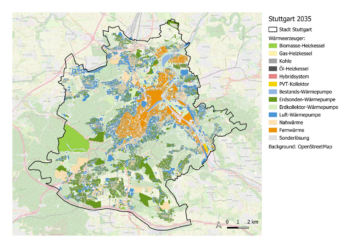What is a Utility Analysis?
Aim and Application of the Utility Analysis
Utility analysis is an analysis and evaluation procedure used in complex decision-making situations. It is used for personal as well as for economic, operational, or technical decisions. The aim is to make decisions between different options, e.g., use of solar thermal, heat pump, or CHP, based on a selection of criteria, e.g., quality, price, environmental impact, acceptance, and number of reference projects.
By using weighted evaluation criteria, it is possible to compare very different options for action in order to achieve the most sensible and best possible result from a holistic point of view.
Procedure for Preparing the Utility Analysis
The same procedure is always followed when performing a utility analysis, which is described step by step below and explained with examples.
1. Explanation of Initial Position and Decision Situation
First of all, it is determined by what a decision is to be made. At least two and up to 10 options for action are defined (experience shows that a maximum of 7 would be the best). The options must be clearly formulated in order to emphasize the respective differences.

2. Compile and Define Criteria for Evaluation
Subsequently, evaluation criteria must be compiled and precisely defined. Based on these criteria, the evaluation of the options for action is carried out in the course of the analysis, and it is determined to what extent the named options for action fulfill these criteria.

3. Weighting of the Criteria
Für die Entscheidungsfindung weisen die festgelegten Bewertungskriterien eine unterschiedliche Wichtigkeit auf. Dafür werden die zuvor gewählten Kriterien individuell von verschiedenen Stakeholdern gewichtet, um deren unterschiedliche Präferenzen auszudrücken. Ein kostenorientiertes Unternehmen gewichtet etwa den Preis besonders hoch, während ein anderer Betrieb mehr Wert auf die Qualität legt.
Zur Gewichtung der Bewertungskriterien können verschiedene Methoden angewendet werden, häufig wird das „SIMOS“-Verfahren genutzt. Üblicherweise besitzen alle Stakeholder das gleiche Stimmrecht, jedoch kann auch eine Gewichtung der Stimmrechte untereinander erfolgen.
Für die resultierende Gesamtgewichtung eignet sich eine prozentuale Verteilung und Darstellung, wobei die Summe der Einzelgewichtungen aller Kriterien 100% ergibt (siehe Abbildung 3).
For the decision-making process, the defined evaluation criteria have different importance. For this purpose, the previously selected criteria are weighted individually by different stakeholders to express their preferences. A cost-oriented company, for example, weights price particularly highly, while another company places more value on quality.
Various methods can be used to weight the evaluation criteria, and the “SIMOS” method is frequently used. Usually, all stakeholders have the same voting rights, but the voting rights can also be weighted among each other.
For the resulting overall weighting, percentage distribution and representation is suitable, whereby the sum of the individual weightings of all criteria results in 100% (see Figure 3).

4. Determine the Evaluation Standard for each Criterion
Now the criteria must be made measurable and comparable with each other. The key question here is to determine how each criterion is met by the option to be evaluated.
For this purpose, an evaluation scale must be defined that is unambiguous and practicable so that all decision-makers understand the scale in the same way. A typical scale, for example, is a point system from 1 to 10.
This means:
10 points = criterion is completely fulfilled
1 point = criterion is not fulfilled at all
Here, it should be defined more precisely for the corresponding criterion when fully met (e.g., efficiency > 95 %).
Note: Likewise, the definition of the scale per criterion can be done before the weighting of the criteria. In this way, stakeholders can better decide which relevance they assign to the individual expressions of a criterion. This can circumvent a possible distortion of the scoring but makes the weighting (step 3) more complicated.
5. Evaluation of the Options for Action Based on Each Criterion
In the evaluation, points are assigned per criterion and action option according to the defined scale. Multiplying the individual scores (scoring from step 4) by the weighting factor of the criterion (from step 3) gives the final weighted score.
6. Summing up and Evaluating the Utility Analysis
To obtain a final result for each action option, the scores of the action options for the individual criteria are summed up (see Figure 4). The action option with the highest total score best fulfills the defined criteria and thus has the greatest overall benefit.
Whether this or another course of action is chosen must be critically reviewed and reflected upon again. In this reflection, the results of the utility analysis show where the strengths and weaknesses of the individual options for action lie. In this way, options for action can be specifically adapted and thus improved.
For example, a conscious decision can be made in favor of a different course of action, e.g., to reduce investment risks.

Overview of advantages and disadvantages of a utility analysis
+ Well feasible and comprehensive method
+ evaluation criteria are assessed and evaluated quantitatively and qualitatively
+ enables comprehensible decisions based on a holistic analysis of options for action
o weighting of criteria is subjective, but this is desired
– unclear if too many options for action and requirement criteria are available (mostly not critical)
– unambiguous definition of evaluation scales as well as options for action are demanding and can be complicated


